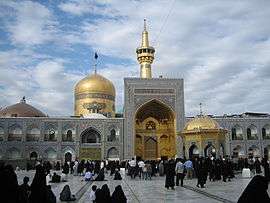Blue Mosque, Tabriz
| The Blue Mosque of Tabriz | |
|---|---|
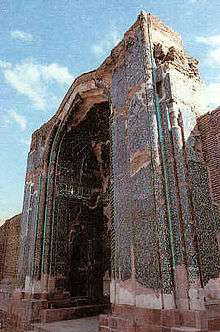 | |
 Shown within Iran | |
| Basic information | |
| Location |
|
| Geographic coordinates | 38°04′24.91″N 46°18′03.88″E / 38.0735861°N 46.3010778°ECoordinates: 38°04′24.91″N 46°18′03.88″E / 38.0735861°N 46.3010778°E |
| Affiliation | Shia Islam |
| Municipality | Tabriz County |
| Province | East Azerbaijan Province |
| Architectural description | |
| Architectural type | Mosque |
| Completed | 1465 |
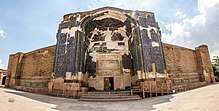
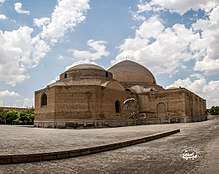
The Blue Mosque (Azerbaijani: گؤی مسجید, Goy Masjed; Persian: مسجد کبود, Masjed-e Kabūd) is a famous historic mosque in Tabriz, Iran. The mosque and some other public buildings were constructed in 1465 upon the order of Jahan Shah, the ruler of Kara Koyunlu.[1]
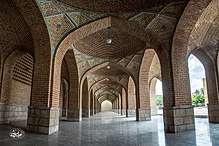
The mosque was severely damaged in an earthquake in 1780,[2] leaving only the iwan (entrance hall).[3] Reconstruction began in 1973 by Reza Memaran Benam under the supervision of Iranian Ministry of Culture. However, it is still incomplete.

History

The Blue mosque of Tabriz was built upon the order of Jahan Shah the ruler of Kara Koyunlu dynasty which made Tabriz the capital of his Kingdom. His Kingdom covered major parts of modern Iran, Azerbaijan, and Turkey. He was killed by Uzun Hassan (the ruler of Ak Koyunlu) and buried on the only parts of the mosque that survived.
The mausoleum was built in the southern section of the mosque and is entirely covered with high marble slabs on which verses from Quran are engraved in Thuluth script on a background of fine arabesques. The roof of the mausoleum and the main dome chamber of the mosque collapsed during an earthquake in 1780. The mosque was rebuilt in 1973. Reconstruction is performed by plans and supervision of Mohammad Reza Memaran Benam, a traditional architect from Tabriz, with authority of the Iranian Organization of Cultural Heritages.
Calligraphy
The diverse Kufic, and Thuluth scripts, the arabesque patterns, and the choramatic compositions of these facades, were created by Nematollah-ben-Mohammad-ol-Bavab, the famous calligrapher. The walls inside and outside had been covered with mosaic tiles.
Photo gallery
 The Blue Mosque entrance, in a snowy day.
The Blue Mosque entrance, in a snowy day. Entrance
Entrance Inside
Inside One of the inner doors.
One of the inner doors.- Entrance (night)
 The Blue Mosque in 1969
The Blue Mosque in 1969- Inside (night)
- Inside (night)
- Inside (night)
- Jahan Shah Grave at Southern Part of the Mosque.
 The Blue mosque before reconstruction.
The Blue mosque before reconstruction.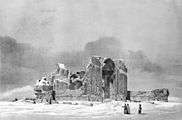 Ruins of Blue Mosque, Eugène Flandin 1841.
Ruins of Blue Mosque, Eugène Flandin 1841. A 19th century sketch of blue mosque.
A 19th century sketch of blue mosque.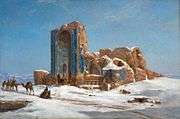 Painting of Blue mosque by a French tourist, Jules Laurens, 1872.
Painting of Blue mosque by a French tourist, Jules Laurens, 1872. Remnants of the original tiling that are broken in earthquake, on show in southern shabistan of Blue Mosque.
Remnants of the original tiling that are broken in earthquake, on show in southern shabistan of Blue Mosque. Tiles on one of the walls in Blue mosque.
Tiles on one of the walls in Blue mosque. Panoramic view of entrance to Blue Mosque from street.
Panoramic view of entrance to Blue Mosque from street.
Notes
- ↑ Newman 2006, p. 158.
- ↑ Melville 1981, p. 170.
- ↑ Berberian 2014, p. 224.
References
- Melville, Charles (1981). "Historical Monuments and Earthquakes in Tabriz". Iran. 19: 159–77.
- Newman, Andrew J (2006). Safavid Iran: Rebirth of a Persian Empire. I.B. Tauris.
- Berberian, Manuel (2014). Shroder Jr., J.F., ed. Earthquakes and Coseismic Surface Faulting on the Iranian Plateau. 17. Elsevier.
- Persian Bulletin of Blue Mosque, Iranian Cultural Heritages Organization.
- http://www.eachto.ir
See also
External links
![]()
- Blue Mosque of Tabriz official website
- Blue Mosque (Kaboud Mosque) introduction in UNESCO web site
- Tishineh
